40“Souvenir of a pilgrim’s visit to the tomb of Emam Reza at Mashhad,” from a set of devotional posters celebrating the Shiʿi dimension of the Islamic faith
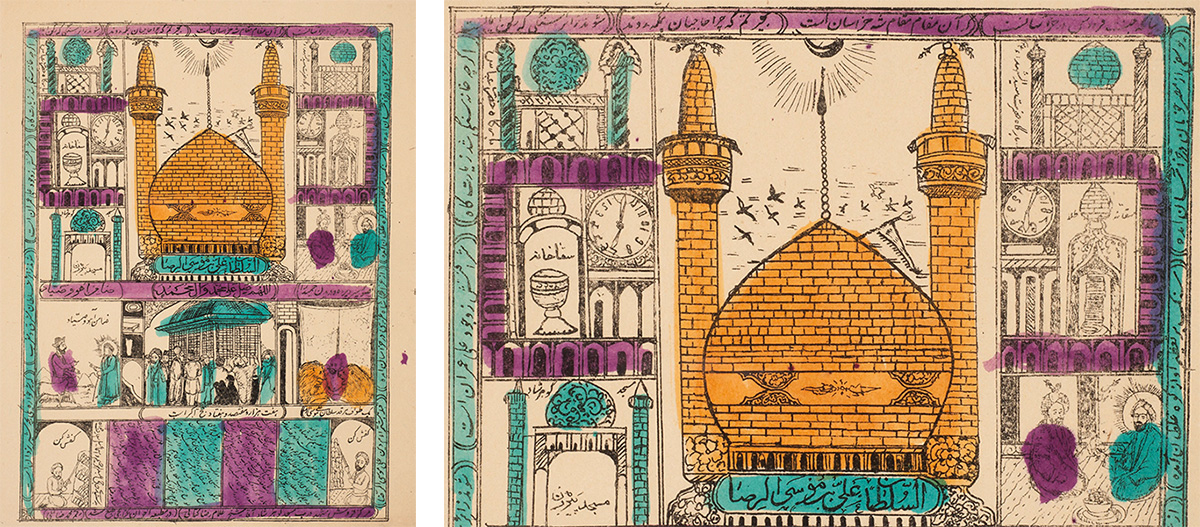
Iran, ca. 1930–45 Mohammad Saneʿi (d. after 1945) Lithographic print on paper, colored by hand, probably from an etching 16.53 × 13.78 in. (42 × 35 cm) Wereldmuseum, Leiden, 7031-32u Photograph courtesy of the museum
An early specimen of its kind, this poster constitutes an early twentieth-century development of commodified pilgrimage souvenirs that had been prepared as scrolls for many centuries. On previous scrolls, such elements were arranged horizontally or vertically (the earliest examples) and viewed in an incremental manner (Marzolph 2014, 2023) (fig. 1).

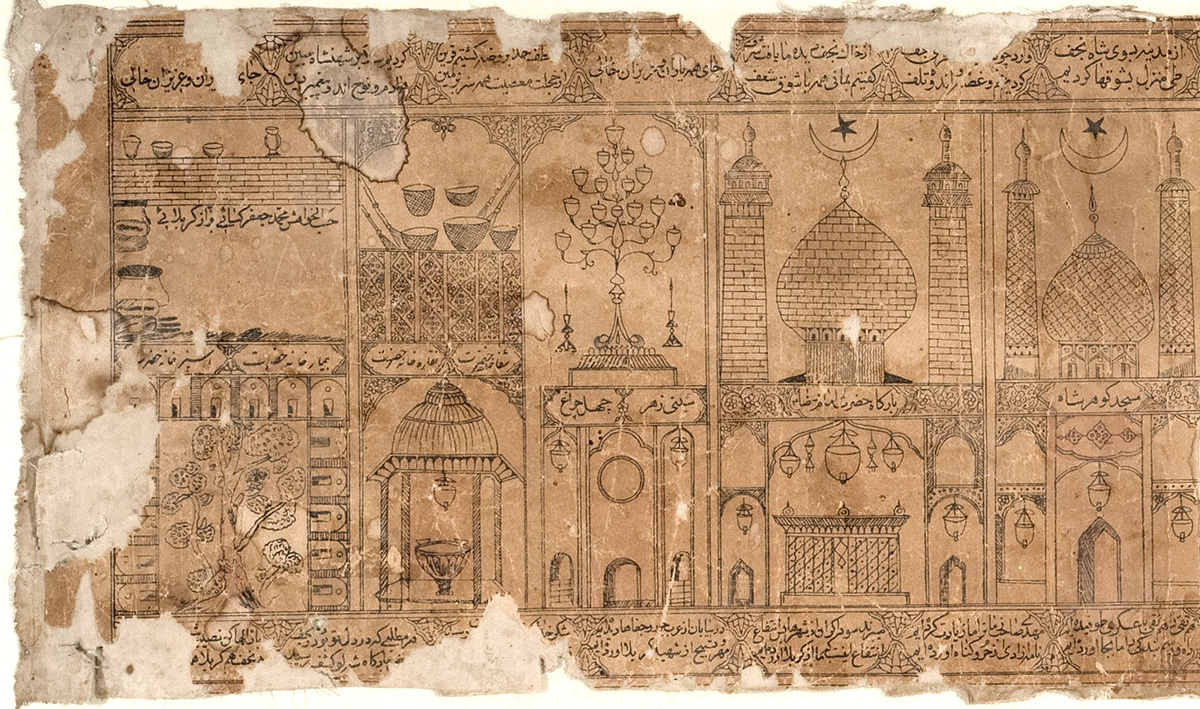
Gradually, these scrolls were turned into posters (Puin 2008, vol. 2, 615–21; vol. 3, 941, M-17). Rather than presenting a single character or event, these single-sheet posters consisted of a variety of elements, all identified by inscriptions. Many included depictions of Mecca, the tombs of the Twelve Emams, and the emams themselves (figs. 3–4). Their execution was casual, indicating that they were mass-produced. Blotches of watercolor (orange, purple, green, turquoise) often added appeal.
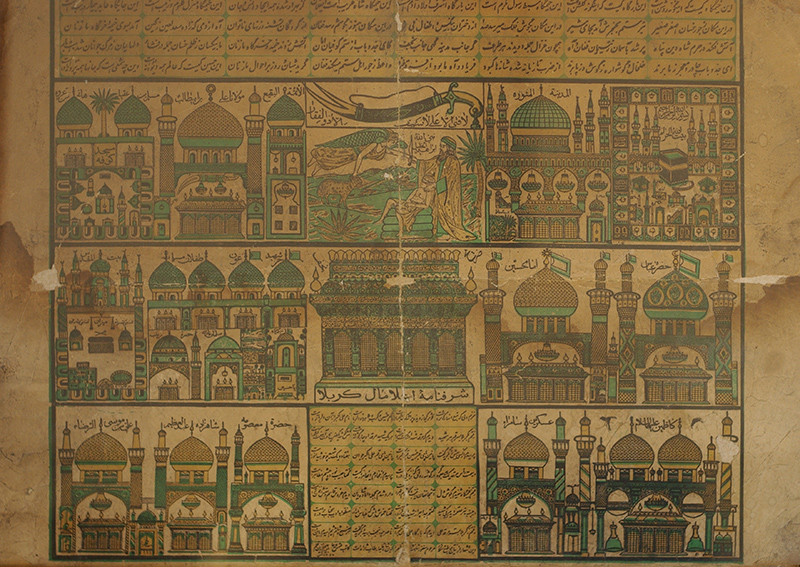
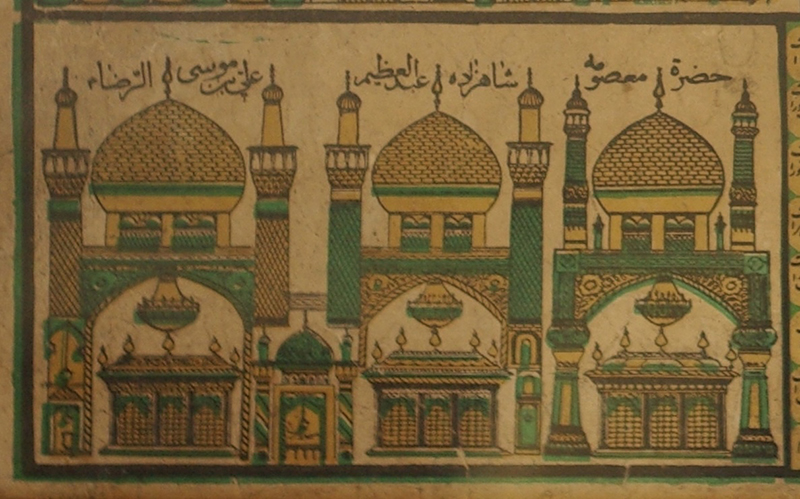
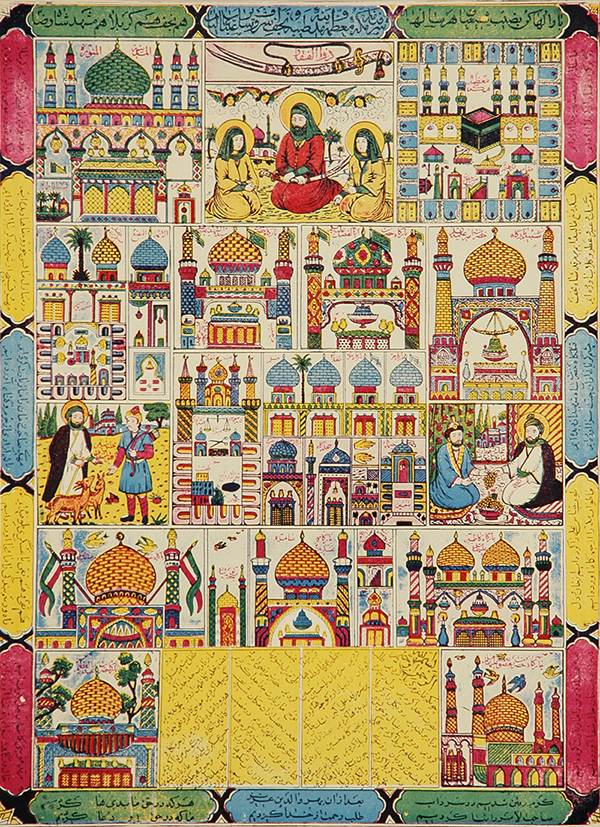

This poster, which belongs to a set of twenty-one by Mohammad Saneʿi (see no. 30), focuses on the Shrine of Emam Reza (map), the burial place of ʿAli b. Musa al-Reza (d. 818), the eighth Shiʿi emam and the only one of the Twelve Emams buried on Iranian soil. It can be compared to several slightly later examples. A poster from the 1940s with a very similar layout but more carefully executed images and color printing is preserved in the Harvard Fine Arts Library (fig. 5). Another one, probably from the 1960s, was acquired in the 1970s by the author (Marzolph 2014, 234, fig. 27) (fig. 6).
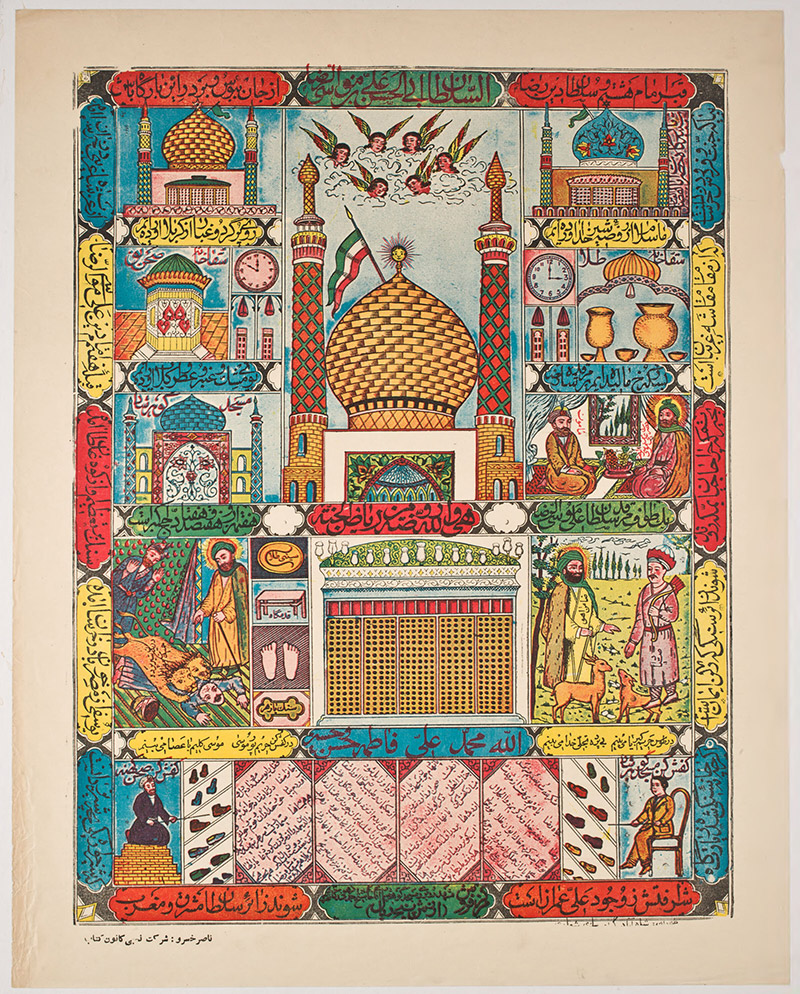
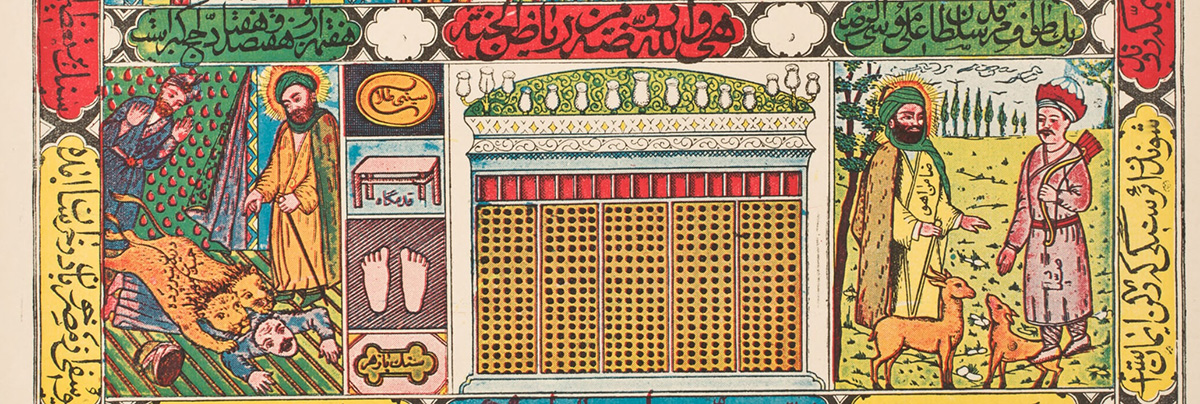
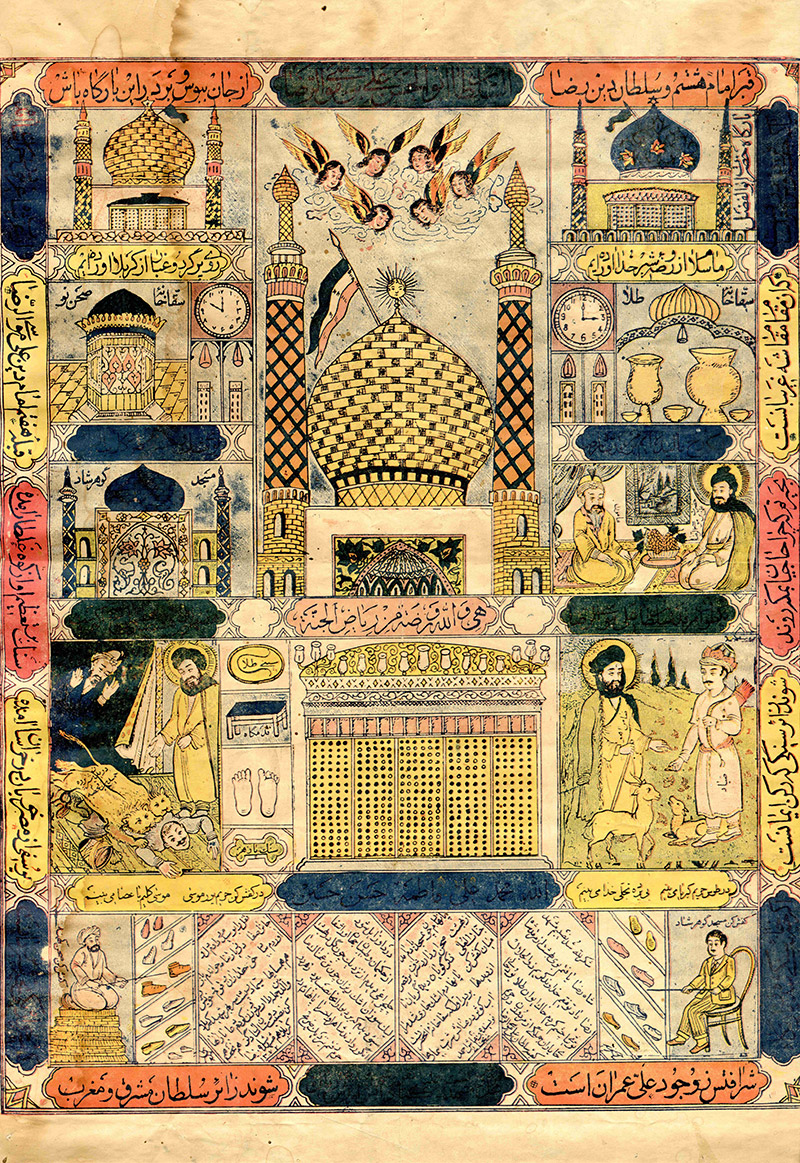
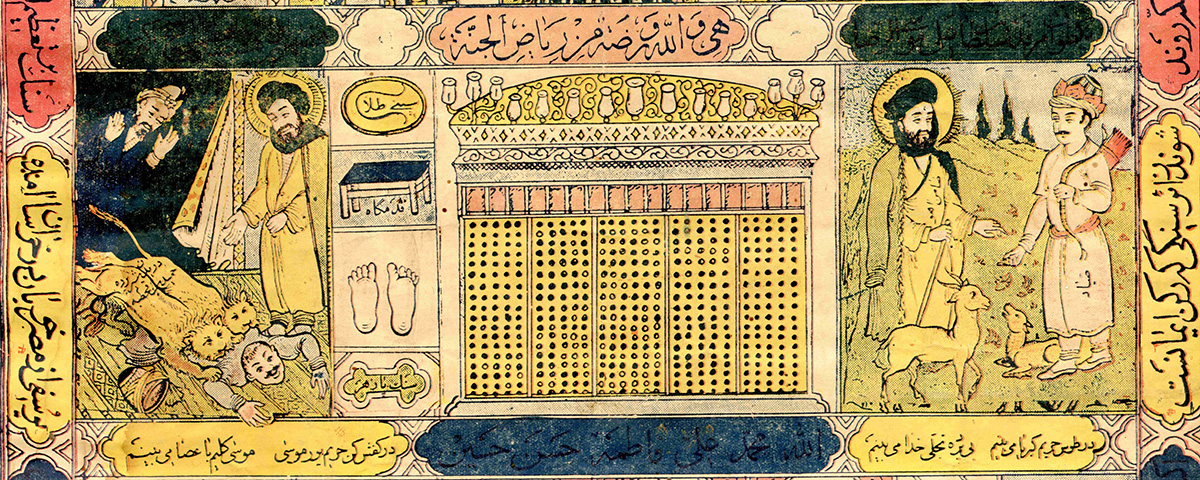
The middle of this poster depicts the tomb (haram) of Emam Reza. The tomb’s golden dome (colored orange) is flanked by two minarets, and below is the pierced grill (zarih) that encloses the emam’s cenotaph. A group of male and female pilgrims gather around the grill, and one of them touches it aiming to acquire the emam’s blessing (fig. 7). The women are clad in a black chador, a large piece of cloth veiling their whole body, and the men wear different costumes, probably indicating the emam’s appeal for every member of the Shiʿi community. A horizontal band of script below describes the pious visit to the emam’s shrine as equaling more than 7,770 times the hajj, the pilgrimage to Mecca.
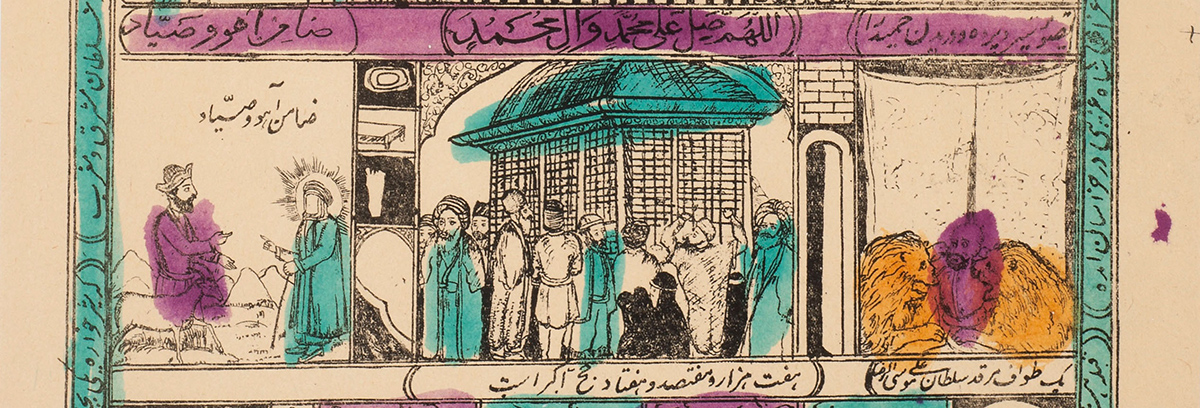
Two images flank the depiction of pilgrims at the zarih. On the left is the famous scene characterizing Emam Reza as the zamen-e ahu, the “sponsor” or protector of the gazelle caught by a huntsman (see no. 42). On the right is one of Emam Reza’s miracles: when he brought to life two lions on a curtain who then tore the disbeliever Hamid b. Mehran to pieces. These two images are separated from the central image by a variety of motifs related to Emam Reza, including the plate on which he was served poisoned grapes and his footsteps, which are venerated at Qadamgah near Neyshabur (map).
In the upper right and left corners of the poster (see main image) are stereotyped small images of two other important Shiʿi sanctuaries: the adjacent shrines of ʿAli’s son Hosayn (the third emam, d. 680) and the latter’s half-brother ʿAbbas (d. 680) at Karbala (map). Below are representations of the Mashhad sanctuary’s clock towers and wells (saqqa-khaneh), which offer water to pilgrims. Below the well on the left is an image of the Gowharshad mosque (819–21/1416–18) (map), its dome colored blue. The corresponding scene on the right shows Caliph Harun al-Rashid offering poisoned grapes to Emam Reza (compare to fig. 4).
The poster’s lower section is divided into six fields (fig. 8). The outer two contain images of the guardians of shoes at the entrances to the shrine, together with the request to take off one’s shoes (kafsh kan!). The four middle sections, as well as the band of writing framing the poster, contain a versified narrative of the pilgrims’ experience performed by their guide or leader (chavosh or chavush). The line at the very bottom in purple mentions the entrance of the Gowharshad mosque as the place where the poster was sold, likely to pilgrims to take home as souvenirs. It also names the printing establishment of the brothers ketabchi and identifies Mohammad Saneʿi as responsible for the poster’s raqm, likely in reference to both its drawing and calligraphy.

Sources:
- Puin, Elisabeth. Islamische Plakate: Kalligraphie und Malerei im Dienste des Glaubens. 3 vols. Dortmund: Verlag für Orientkunde, 2008. [WorldCat]
- Marzolph, Ulrich. “From Mecca to Mashhad: The Narrative of an Illustrated Shiʿi Pilgrimage Scroll from the Qajar Period. Muqarnas 31 (2014): 207–42. [Archnet]
- Tamimi Arab, Pooyan. “Devotie-afbeeldingen van de profeet Mohammed in het Nationaal Museum van Wereldculturen.” ZemZem: Tijdschrift over het Midden-Oosten, Noord-Afrika en de islam 2 (2016).
- Marzolph, Ulrich. “Shii Perspectives on Hajj: Illustrated Souvenir Scrolls of Hajj and Ziyārat.” In The Hajj and the Arts of Pilgrimage: Essays in Honour of Nasser David Khalili, edited by Qaisra M. Khan with Nahla Nassar, vol. 1, 219–40. London: Gingko, 2023. [WorldCat]
Citation: Ulrich Marzolph, “‘Souvenir of a pilgrim’s visit to the tomb of Emam Reza at Mashhad,’ from a set of devotional posters.” Catalog entry in The Emamzadeh Yahya at Varamin: An Online Exhibition of an Iranian Shrine, directed and edited by Keelan Overton. 33 Arches Productions, January 15, 2025. Host: Khamseen: Islamic Art History Online.
